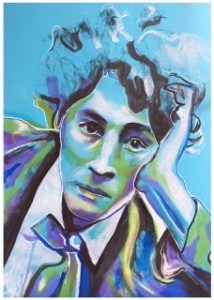Stock Exchange 1.0
The world’s first known stock exchange is thought to be a market established in Bruges, Belgium, around 1309. This operation was a family concern conducted in the home of textile merchant Robert Van der Burse (or Van “ter Buerse/Buerze”). This type of early market which primarily deals with the exchange of commodities, ie, various agricultural products—and in its modern connotation, also with gas, oil, coal, etc—acquired the name ‘bourse’ from its founder. A bourse (typically European in location) is “a market organised for the purpose of buying and selling securities, commodities, options and other investments” [‘Bourse’, Investopedia, www.investopedia.com]. Another early bourse was located in Antwerp<a̷>.

𝕍𝕒𝕟 𝕕𝕖𝕣 𝔹𝕦𝕣𝕤𝕖: 𝕥𝕙𝕖 𝕠𝕣𝕚𝕘𝕚𝕟𝕒𝕝 𝕓𝕠𝕦𝕣𝕤𝕖
The Van der Burse exchange was the first organised market, before this landmark development such transaction processes were unorganised and informal – sellers and buyers would meet up one-to-one at specific meeting places such as town squares to conduct their trade <b̷> [‘Creation of the first stock exchange’, www.citeco.fr].
The Dutch, pioneers of capitalism
For the first ‘modern’ securities market we need to look to Belgium’s neighbours, the Dutch. The Amsterdam Stock Exchange is the oldest such market, founded in 1602 with the establishment of the Dutch East India Company (Verenigde Oostindische Compagnie or VOC). Amsterdam was the first bourse to deal in securities <c̷>. The VOC was empowered with quasi-government and monopoly status by the States General of the Netherlands, granted a 21-year charter to conduct all Dutch trade in Asia. In so doing, financial history was made…the VOC was a world first, a public company founded by a state government. Hitherto the Dutch trading environment comprised a number of competing private companies known as voorcompagnieën or “pre-companies”. By the 1602 Charter, the government merged those small, private companies into one “nationalistic Goliath”, VOC, creating a proto-megacorporation.
 𝟙𝟞𝟘𝟚 ℂ𝕙𝕒𝕣𝕥𝕖𝕣 𝕕𝕠𝕔
𝟙𝟞𝟘𝟚 ℂ𝕙𝕒𝕣𝕥𝕖𝕣 𝕕𝕠𝕔Raising capital
At VOC’s commencement of business it held an unprecedented initial public offering (IPO). The company’s directors opened up share-holding to all Dutchmen by subscription (while investing 12,000 guilders of their own money up front). The public nature of the share issue was its revolutionary feature, hitherto predecessor companies (like the Oude Compagnie) had raised capital from a small circle of private investors. Some investors balked at the opportunity offered by VOC, wary of tying up their precious savings for such a long period (ten years). Concessions made by the VOC eased these concerns – in a subsequent amendment to the charter, investors were permitted to on-sell their shares to a third party prior to ten years [‘The world’s first IPO’, Lodewijk Petram, The World’s First Stock Exchange’, 15 October 2020, www.worldsfirststockexchange.com].
 𝔸𝕞𝕤𝕥𝕖𝕣𝕕𝕒𝕞 𝕊𝕥𝕠𝕔𝕜 𝔼𝕩𝕔𝕙𝕒𝕟𝕘𝕖 𝕒𝕟𝕕 𝕓𝕦𝕝𝕝
𝔸𝕞𝕤𝕥𝕖𝕣𝕕𝕒𝕞 𝕊𝕥𝕠𝕔𝕜 𝔼𝕩𝕔𝕙𝕒𝕟𝕘𝕖 𝕒𝕟𝕕 𝕓𝕦𝕝𝕝What would NOT have seemed novel to financial market investors of the day was the ‘office’ for doing business…initially lacking a business premises the VOC—after the fashion of the Bourses’ 14th century Bruges exchange—issued an open invitation for would-be investors to come to the private home of the company co-founder Dirck van Os to do the paperwork and deposit their money. Ultimately, by the time subscriptions closed, some 1,143 individuals <d̷> had invested a total of 3,674,945 guilders in the Verenigde Oostindische Compagnie (including Dirck van Os’ own maid!) [Petram].

ℕ𝔸𝕊𝔻𝔸ℚ (ℙ𝕙𝕠𝕥𝕠: 𝕄𝕒𝕣𝕜𝕖𝕥𝕤𝕎𝕚𝕜𝕚)
Footnote: the VOC’s IPO had profound ramifications, fundamentally altering the nature of investing. Originally intended to facilitate the financing of risky capital-intensive ventures, it “inadvertently created an alternative for investor beyond fixed income investments, marking the beginning of retail investing in equities” [‘World’s First IPO: Dutch East India Co’, Suede Investing, www.suedeinvesting.com].
•°¯`••••´¯°• •°¯`••••´¯°•
<a̷> the most famous bourse today is that of the Paris Stock Exchange
<b̷> including the square in front of the Van der Burse residence
<c̷> printed stocks and bonds, debt and other interests in companies, government and private businesses
<d̷> in addition to the six directors






















